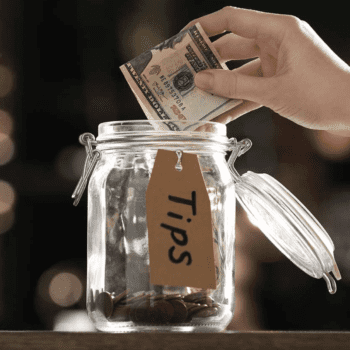 How tips are distributed can quickly become a hot topic in restaurants and hotels. Employees care about justice and want to be rewarded according to their efforts.
How tips are distributed can quickly become a hot topic in restaurants and hotels. Employees care about justice and want to be rewarded according to their efforts.
Is it fair that a server who is capable to deliver a better service than his or her colleagues (and gets more tips) has to put all the money earned in a pot that will be equally shared with other employees? Or, is it fair that a server keeps all the tips received when part of the excellent customer experience is also shaped by fellow colleagues (chefs, runners, bartenders)?
None of these systems is totally fair, but they are used in many restaurants and hotels. However, research is being made into alternative ways to share tips.
Hospitality industry’s new tipping system: What you need to know
In 2020, the first author of this article was tasked with a senior colleague to design a new system to create a transparent and fair distribution of tips among the F&B department in a three-star superior hotel in Switzerland. Around 65 employees worked in the hotel, and 27 worked in the F&B department. The restaurant had seven stations inside and three outside on the terrace, with 160 seats. The food was prepared in a central kitchen for all stations. The barkeepers prepared the beverages for the runners and chefs de rang to bring to the tables.
Before the introduction of the new tipping systems, chefs de rang were expected to share 20% of their tips with the kitchen and bar staff, but since there was no control mechanism, it was rarely executed. It created mistrust between colleagues and strained relationships between the service staff and the kitchen crew.
The new tipping system required each chef de rang (responsible for a station) to put 1% of their daily revenue into a shared tip pot. The chef de service or deputy collected the money while checking the final bill for each station at the end of each day. The choice of 1% was made on the assumption that every server was making at least a 5% tip on their revenue of the day, which would leave them with 4% at minimum. This percentage aligns with other figures demonstrating that customers provide tip amounts averaging 3-4% of the bill in Swiss restaurants (Fernandez et al., 2016; Gössling et al., 2020).
For instance, if a chef de rang generated CHF 1200 revenue for one day and received CHF 85 as tips, they would have to take 12 CHF from the tips earned to put them in the shared pot. The chef de rang would therefore keep CHF 73. The following day, the chef de service (or deputy chef de service) would give 75% of the collected money to the chef de cuisine, again allowing him/her to check the amount received with the final bill. The rest (25%) would be distributed evenly among the food runners, bar personnel and the chef de service. A larger percentage would be given to the kitchen because there are more employees in this department. With a 50/50 split, each person working in the kitchen would have received almost nothing.
Since a greater number of personnel are usually where a higher revenue is generated, the CHF amount was relatively constant for all supporting elements (runners, barkeepers, chef de service). The money earned each day varied a lot, but each supporting element would get on average CHF 10-20, while chefs de rang could earn 50 CHF or more.
The management team recognized and resolved a significant problem that emerged early on. Indeed, different-sized stations in the restaurant gave the respective chefs de rang different tip amounts, so it was decided to rotate the chef de rang through the stations. This was beneficial from a training point of view and in keeping morale high among the servers. This resulted in the new tipping system being quickly adopted by the staff.
The beneficial effects of this tipping system for the employees
It is well documented that employees who perceive their work environment as fair are more satisfied, more committed to their employer, make more effort, perform better, and are less likely to quit (Colquitt et al., 2001). Keeping in mind that employees are more motivated when the rewards received align with their effort, the tipping system described in this article was fair in many aspects.
We can summarize the beneficial effects of this system as follows. It motivated chefs de rang to deliver exceptional service, the tipping system was based on accurate information, and all employees who contributed to shaping excellent service were rewarded.
Interestingly, this new tipping system allowed chefs de rang to keep the most significant share of their tips. It might be painful for them to share a very large part of their tips with their colleagues, particularly when tips reward their unique interaction with customers. In some servers’ mind, they own their tips.
Hence, the main benefit of the new tipping system is to push them to deliver excellent service and generate revenue. This is reinforced by tips being given at the end of each day. Considering that there was no delay between service behaviors and the financial reward, tips could positively reinforce excellent service behaviors (e.g., giving an extra chocolate to the kids, asking with a smile how the meal was).
The new tipping system supported then chefs de rang’s effort to better serve guests. On the contrary, the practice of servers earning their tips at the end of the week or month poses a potential danger, as it fails to align with the principles of operant conditioning, which states that delayed reinforcement diminishes its effectiveness as a motivator, rendering it less likely to positively influence behavior.
An inclusive and fairer tipping system
This system was fair as it was based on objective information (revenue). It was hence not possible for employees to cheat. In other restaurants, chefs de rang are required to share a fixed percentage of the tips earned. When employees have to distribute a percentage of the tips earned, it can be tempting for some of them to minimize the amount received to not lose too much money, but here it was not possible to manipulate revenues as they were already entered into the system. Moreover, employees could examine if the amount received every day was fair because there was a document where all these pieces of information were recorded.
The system was also fair because all chefs de rang rotated between stations. Some stations generated more revenues than others. Therefore, if chefs de rang were strictly allocated to these stations, they would generate more revenue and more tips. The rotating system was implemented to ensure that all chefs de rang had an equal opportunity to get tips.
The new tipping system allowed all employees involved in the restaurant to earn tips. This feels fairer because they all contribute one way or another to the customer experience. These “supporting elements” receive fewer tips than chefs de rang, but this can be justified for two reasons. First, they are not in direct contact with the guest (or have less contact), thus, they have less of an impact on the overall guest satisfaction. Second, some of them (chefs de service and kitchen chefs) receive a higher base salary than chefs de rang. It could be perceived as unfair if they get the same amount as the latter.
In many hotels, there exists a points system where employees with a higher status receive a larger percentage of tips than chefs de rang even if they have less contact with guests, despite earning higher salaries. In the hotel depicted in this case, it was not the seniority, age or personality that determined the tip share but the contribution to the guest’s overall experience.
It is also important to note that apprentices and interns did count the same as regular employees in the daily business. If they had a station, they would keep their tips as a more experienced chef de rang; if they were food runners or behind the bar, they would get the same percentage as a supporting employee on that day.
How to implement the innovative tipping system into the industry
The tipping system depicted in this article presents many advantages. First, it presents the advantage of the tip-keeping system, in which waiters retain most of their tips. Second, it keeps the advantage of the tip-pooling system, in which employees that do not normally get tips earn a share of them. Third, the way tips are shared is transparent, known in advance, and based on objective information (revenue). This kind of system is hence very likely to be perceived as fair and motivating for most employees.
Despite these advantages, this kind of system should take into consideration the local norms, culture and constraints. For instance, the specific percentage of revenue (1%) allocated to the shared pot might be modified. Even in the restaurant described in this article, the management team now realizes that giving 1% of revenue might not compensate enough for the supportive elements. Implementing a 2% system is now considered fairer and adapted to the current situation. If the average tip amount still represents 4-5% of the revenue, chefs de rang would still keep 2-3% of their revenue, while the rest of the staff would get 2%.
Authored by:


 Sébastien Fernandez
Sébastien Fernandez
















